With all the bad news and negative stuff we hear in our information overloaded, 24-hour news cycle world, it is great to occasionally hear a story that restores our faith in human nature. Our first report, a follow-up on the terrible fire that destroyed Chesapeake Boats in Crisfield, MD, is just such a gem.
Totch Hartge, president of Hartge Insurance in Galesville, MD, sends us this great story. “Just a few weeks ago, Chesapeake Boat builders burned to the ground. (I am not their agent) There are only two boat builders in town, Evans Boats and Chesapeake, and they are pretty serious longtime competitors, building workboats, excursion boats, pirate ships, and the like. Chesapeake’s fire was devastating for the community, and this story might not happen somewhere else: Eugene and Rose Evans (yes my clients) immediately opened up one of their two big boatbuilding sheds to David Mason, owner of Chesapeake. He is already building his next boat. When I said ‘Wow,’ Eugene said it is about family and jobs and the right thing to do, in his honest and straightforward way. As another part of the story, when all the local firefighters from three counties arrived, it was Eugene’s son David who helped drag the only saved boat mold out the door. He said when it cleared the building, a fireball followed right behind it. It is that mold that will give them (Chesapeake) their first new boat. Pretty great.”
Jon Newton of Hartge Yacht Yard in Galesville, MD, reflects on a busy season. “We are finishing up six coats of Pettit Z-Spar 1215 Captain’s varnish on a couple of good looking boats, a new black metallic Chris Craft Launch 25 and a Wasque 26. A buyboat came in for repair of small gouges to her planks below the rub rail. As Ernie Stuermer examined the gouge, he uncovered some iron fastener deterioration in the plank, which led to a bad frame. A short plank is not a good thing, which led to a longer plank removal that uncovered another bad frame. The new plank is half lapped, glued and fastened to the original plank, producing a really strong joint that doesn’t show. It is a much better structure than the traditional butt system. Also this boat was built with full length planks, not butts, so this type of repair is appropriate.
A travelift strap cracked a teak cap on a Defever Trawler, and under that was a loose hull to deck joint. The joint is glued and fastened back together and a new eight-foot teak cap rail fitted in place. Pete Bell is working on leaking wheel house side windows in a Stanley 28, ‘A splendid small day boat with overnight accommodations’ as described by the builder, John Williams Boat Company in Maine. The leaks are around the teak frames fit to the curved fiberglass cabin sides to provide a straight path for the glass sliding windows. The bedding had failed after many years and we made a few improvements in the details for better drainage from the track.”
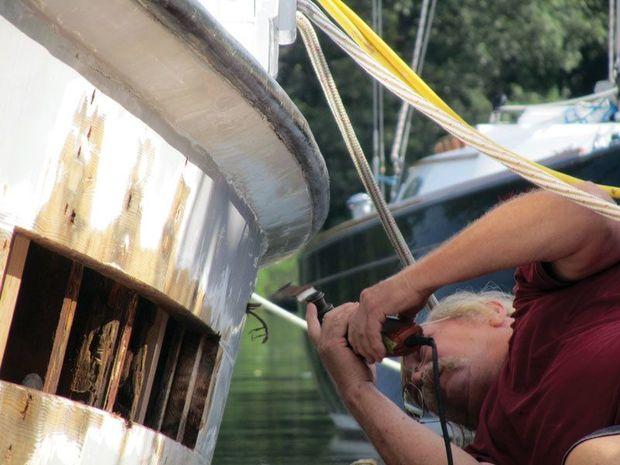
The following excerpt from a recent National Fisherman magazine article was sent by Lloyd Griffin.
David Rollins is restoring the Chesapeake Bay buy boat Linda Carol for William Mullis of Gloucester County, VA, at York Haven Marina in Poquoson, VA. Alton Smith of Susan, VA, built the boat in 1931, but then her name was
Croaker. The 55-foot by 14-foot by four-foot-nine-inch wooden boat had been deteriorating at a Long Island, NY, salvage yard for five years when Mullis found her and brought her back to the Chesapeake Bay. Mullis went to Rollins because he has considerable experience restoring large deadrise boats. Rollins owned the buy boat the
East Hampton which he restored to pristine condition in the 1990s. He’s replacing about 95 percent of
Linda Carol. “She had a good keel and a good bottom, and most of the logging in the stern was good. These things made her worth saving, but everything else will be new,” he said.
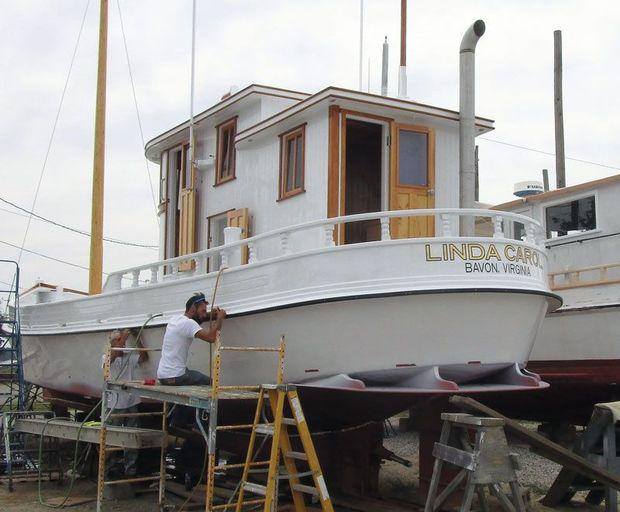 Jake Glover of Ferry Point Marina in Trappe, MD
Jake Glover of Ferry Point Marina in Trappe, MD, has had a busy summer. “The yard has stayed busy keeping boaters on the water. Our mechanics have been steadily performing repairs to inboards (gas and diesel), outboards, and outdrives. The first half of the season has already brought a number of gelcoat, fiberglass, and paint repairs that our yard has been taking care of. A 32-foot bay boat is in for an air conditioning install, and a second Garmin 7612 display added. We’ve knocked out a 25-foot Parker that also received a new Garmin electronics package, fresh bottom paint, and a full detail. A number of electrical repairs, mechanical survey, and detail were completed on a Steiger, prepping her for sale. On the books is a 29-foot Maxum to receive a new Lowrance Radar, Glendenning engine synchronizer, Flex-I-teak application, and some other small repairs. The ship’s store and fuel dock are still open seven days a week!”
Chesapeake Bay Maritime Museum Shipwright Joe Connor reports the boatyard is finishing the sailing log canoe
Flying Cloud’s foremast—a month-long endeavor to construct a Homer Seider-design Sitka spruce spar, the first of its kind to be built in a generation. Constructed in 1932 by celebrated Tilghman Island boat builder John B. Harrison,
Flying Cloud is fashioned from five yellow pine logs. Railway season is also in full swing, with the Hoopers Island draketail, or dovetail
Martha up for a fresh coat of paint.
Martha was built in 1934 for $350 and was used for oyster tonging and trot lining for crabs. These boats have many names, and are referred to as ducktail, draketail, torpedo-stern, or Hoopers Island launches, after the island in Dorchester County, MD, where they originate.
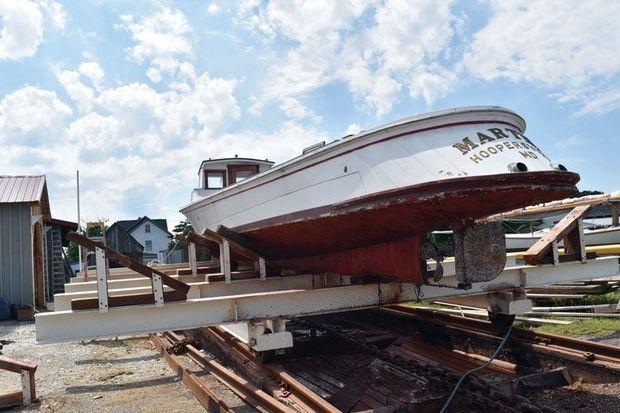 Joe Reid of Mast and Mallet in Edgewater, MD
Joe Reid of Mast and Mallet in Edgewater, MD, reports. “In the yard for repair is a 46-foot Custom Bay Built Yacht constructed of plywood and covered with massive fiberglass. Unfortunately, some fungus started in the port and starboard chines and traveled to the ply. We cut out the affected areas and replaced all with marine ply and epoxy/fiberglass. Another boat in for transom work is a Privateer with a plywood cored transom. We removed the fiberglass sheathing and removed two layers of plywood. It was then recoated with epoxy/fiberglass. A new outboard is scheduled to be installed. At the cosmetic department, a 28-foot Maynard Lowery built boat has received exterior paint throughout and looks ‘mighty fresh.’ My personal endeavor for the past couple of years has been constructing a Chesapeake 22-foot crab boat with an outboard well. The design is similar to the inboard versions I’ve built. At this time, I should be having sea trials, with a 50-hp Tohatsu engine. Contact me for information. Already planning for some wintertime work, a teak transom to be installed on a fiberglass boat and painting thru out on a Dyer 29.”
The always upbeat Carson Forrester of Suffolk, VA, sends us his report: “The Forrester Boat shop has been really busy all summer. We are putting the finishing touches on the 17, and the jig is up on the 21 center console that is being built for Wingman Guide Services. We are talking to several other people about new builds and are very excited about the future! The 17-foot Trout skiff will be for sale, and the listing will be up on the FBW Facebook page shortly.”
Rob Hardy of Composite Yacht in Trappe, MD, sums up the summer. “We continue to keep on keepin’ on here at CY. We’re putting the finishing touches on an outboard powered CY34 Express with twin Yamaha 350s, and have several other builds underway from 26 to 46 feet. We’re also in the design stages of a CG Inspected Charter/ Tour boat. As always, refinishing is a big part of our business, as is retrofitting existing boats with a variety of custom options. We’re inching closer to making the mold to our new 32-foot Offshore boat which is beginning to draw some real interest. Another project we’re inching toward as we work with the state and county is an expansion of our facilities to accommodate the incessant need for more room. So, as luck would have it, we’ve stayed busy all summer long, and look forward to remaining that way.”
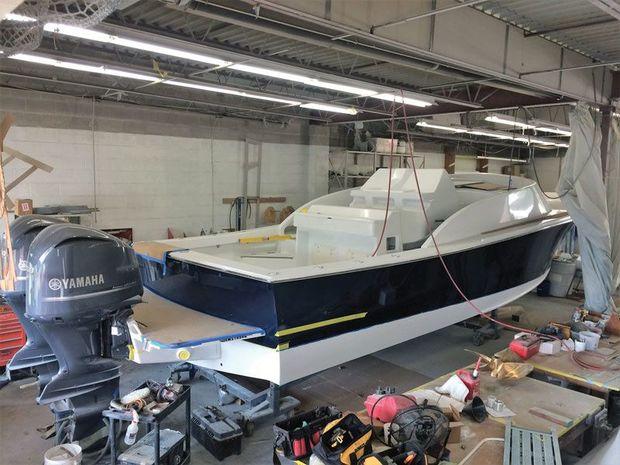 From Mathews Brothers in Denton, MD, Meg Roney
From Mathews Brothers in Denton, MD, Meg Roney reports a busy summer as well. “This summer has had us busy at both our main shop and our Mathews Landing location. Here in the shop, we’ve been working on a complete refit of a 1981 Boston Whaler Montauk to include a complete paint job and upgrading the smaller console to the full size console with the cooler seat in front. We’ve also helped a customer get his Grady White back into shape by spraying new gelcoat in the cockpit and transom and installing his Armstrong bracket and outboard engine.
Mathews Landing has been busy marrying the pilothouse onto the hull of
Crow Bros II as well as continuing systems. We also have a third Dettling enroute to the Landing for a repower. We upgraded electronics and upsized the bow thrusters on the past two Dettlings. Since schools are getting back into session very shortly, we too are looking to the fall. We’ve acquired additional storage space so we have more indoor storage space than ever before, and our low prices are staying the same. Please check us out at
mathewsboats.com/boat-storage to see our prices if you don’t already have a winter home for your boat. Another trademark of the fall is the U.S. Powerboat Show in Annapolis. We are happy to be participating in the show again this year—make sure to come see us!”
[gallery type="rectangular" ids="15688,15689"]
Lauren DiStefano of Bluewater Yacht Yard in Hampton, VA, reports on an unusual project. “Our service yard recently completed modifications to
Cuttin’ Up, a 52-foot Viking yacht. These updates allow the owner’s new motorized scooter more space to maneuver around the boat. On the exterior, cut outs on the bridge overhang were made to move wiring. Next, we had to grind and glass/ modify the bridge opening and then prep and paint the nonskid on the bridge area, from fly bridge access work. We fabricated a bridge elevator platform and ladder lift to allow transferring around the salon, mezzanine, and up to the bridge. On the interior, modifications were made to the companionway wall/ doors (which allowed the doors to be changed to double doors), modifications to bed location, and modifying the shower, as well as removing the head wall and moving the location of the head. Once changes were complete, we were able to reinstall the doors and teak trim. Lastly, we fabricated and fit a new escalator in the companionway.”
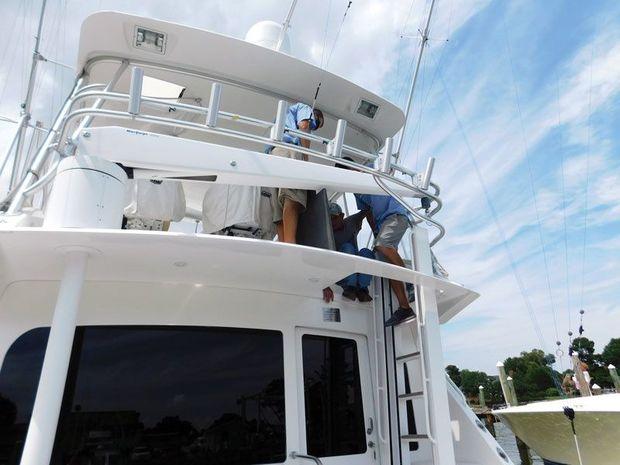 by Capt. Rick Franke
More Photos
by Capt. Rick Franke
More Photos
[gallery type="square" link="file" ids="15691,15692,15693,15694,15695,15696,15697,15698,15699" orderby="rand"]
 The following excerpt from a recent National Fisherman magazine article was sent by Lloyd Griffin. David Rollins is restoring the Chesapeake Bay buy boat Linda Carol for William Mullis of Gloucester County, VA, at York Haven Marina in Poquoson, VA. Alton Smith of Susan, VA, built the boat in 1931, but then her name was Croaker. The 55-foot by 14-foot by four-foot-nine-inch wooden boat had been deteriorating at a Long Island, NY, salvage yard for five years when Mullis found her and brought her back to the Chesapeake Bay. Mullis went to Rollins because he has considerable experience restoring large deadrise boats. Rollins owned the buy boat the East Hampton which he restored to pristine condition in the 1990s. He’s replacing about 95 percent of Linda Carol. “She had a good keel and a good bottom, and most of the logging in the stern was good. These things made her worth saving, but everything else will be new,” he said.
The following excerpt from a recent National Fisherman magazine article was sent by Lloyd Griffin. David Rollins is restoring the Chesapeake Bay buy boat Linda Carol for William Mullis of Gloucester County, VA, at York Haven Marina in Poquoson, VA. Alton Smith of Susan, VA, built the boat in 1931, but then her name was Croaker. The 55-foot by 14-foot by four-foot-nine-inch wooden boat had been deteriorating at a Long Island, NY, salvage yard for five years when Mullis found her and brought her back to the Chesapeake Bay. Mullis went to Rollins because he has considerable experience restoring large deadrise boats. Rollins owned the buy boat the East Hampton which he restored to pristine condition in the 1990s. He’s replacing about 95 percent of Linda Carol. “She had a good keel and a good bottom, and most of the logging in the stern was good. These things made her worth saving, but everything else will be new,” he said.
 Jake Glover of Ferry Point Marina in Trappe, MD, has had a busy summer. “The yard has stayed busy keeping boaters on the water. Our mechanics have been steadily performing repairs to inboards (gas and diesel), outboards, and outdrives. The first half of the season has already brought a number of gelcoat, fiberglass, and paint repairs that our yard has been taking care of. A 32-foot bay boat is in for an air conditioning install, and a second Garmin 7612 display added. We’ve knocked out a 25-foot Parker that also received a new Garmin electronics package, fresh bottom paint, and a full detail. A number of electrical repairs, mechanical survey, and detail were completed on a Steiger, prepping her for sale. On the books is a 29-foot Maxum to receive a new Lowrance Radar, Glendenning engine synchronizer, Flex-I-teak application, and some other small repairs. The ship’s store and fuel dock are still open seven days a week!”
Chesapeake Bay Maritime Museum Shipwright Joe Connor reports the boatyard is finishing the sailing log canoe Flying Cloud’s foremast—a month-long endeavor to construct a Homer Seider-design Sitka spruce spar, the first of its kind to be built in a generation. Constructed in 1932 by celebrated Tilghman Island boat builder John B. Harrison, Flying Cloud is fashioned from five yellow pine logs. Railway season is also in full swing, with the Hoopers Island draketail, or dovetail Martha up for a fresh coat of paint. Martha was built in 1934 for $350 and was used for oyster tonging and trot lining for crabs. These boats have many names, and are referred to as ducktail, draketail, torpedo-stern, or Hoopers Island launches, after the island in Dorchester County, MD, where they originate.
Jake Glover of Ferry Point Marina in Trappe, MD, has had a busy summer. “The yard has stayed busy keeping boaters on the water. Our mechanics have been steadily performing repairs to inboards (gas and diesel), outboards, and outdrives. The first half of the season has already brought a number of gelcoat, fiberglass, and paint repairs that our yard has been taking care of. A 32-foot bay boat is in for an air conditioning install, and a second Garmin 7612 display added. We’ve knocked out a 25-foot Parker that also received a new Garmin electronics package, fresh bottom paint, and a full detail. A number of electrical repairs, mechanical survey, and detail were completed on a Steiger, prepping her for sale. On the books is a 29-foot Maxum to receive a new Lowrance Radar, Glendenning engine synchronizer, Flex-I-teak application, and some other small repairs. The ship’s store and fuel dock are still open seven days a week!”
Chesapeake Bay Maritime Museum Shipwright Joe Connor reports the boatyard is finishing the sailing log canoe Flying Cloud’s foremast—a month-long endeavor to construct a Homer Seider-design Sitka spruce spar, the first of its kind to be built in a generation. Constructed in 1932 by celebrated Tilghman Island boat builder John B. Harrison, Flying Cloud is fashioned from five yellow pine logs. Railway season is also in full swing, with the Hoopers Island draketail, or dovetail Martha up for a fresh coat of paint. Martha was built in 1934 for $350 and was used for oyster tonging and trot lining for crabs. These boats have many names, and are referred to as ducktail, draketail, torpedo-stern, or Hoopers Island launches, after the island in Dorchester County, MD, where they originate.
 Joe Reid of Mast and Mallet in Edgewater, MD, reports. “In the yard for repair is a 46-foot Custom Bay Built Yacht constructed of plywood and covered with massive fiberglass. Unfortunately, some fungus started in the port and starboard chines and traveled to the ply. We cut out the affected areas and replaced all with marine ply and epoxy/fiberglass. Another boat in for transom work is a Privateer with a plywood cored transom. We removed the fiberglass sheathing and removed two layers of plywood. It was then recoated with epoxy/fiberglass. A new outboard is scheduled to be installed. At the cosmetic department, a 28-foot Maynard Lowery built boat has received exterior paint throughout and looks ‘mighty fresh.’ My personal endeavor for the past couple of years has been constructing a Chesapeake 22-foot crab boat with an outboard well. The design is similar to the inboard versions I’ve built. At this time, I should be having sea trials, with a 50-hp Tohatsu engine. Contact me for information. Already planning for some wintertime work, a teak transom to be installed on a fiberglass boat and painting thru out on a Dyer 29.”
The always upbeat Carson Forrester of Suffolk, VA, sends us his report: “The Forrester Boat shop has been really busy all summer. We are putting the finishing touches on the 17, and the jig is up on the 21 center console that is being built for Wingman Guide Services. We are talking to several other people about new builds and are very excited about the future! The 17-foot Trout skiff will be for sale, and the listing will be up on the FBW Facebook page shortly.”
Rob Hardy of Composite Yacht in Trappe, MD, sums up the summer. “We continue to keep on keepin’ on here at CY. We’re putting the finishing touches on an outboard powered CY34 Express with twin Yamaha 350s, and have several other builds underway from 26 to 46 feet. We’re also in the design stages of a CG Inspected Charter/ Tour boat. As always, refinishing is a big part of our business, as is retrofitting existing boats with a variety of custom options. We’re inching closer to making the mold to our new 32-foot Offshore boat which is beginning to draw some real interest. Another project we’re inching toward as we work with the state and county is an expansion of our facilities to accommodate the incessant need for more room. So, as luck would have it, we’ve stayed busy all summer long, and look forward to remaining that way.”
Joe Reid of Mast and Mallet in Edgewater, MD, reports. “In the yard for repair is a 46-foot Custom Bay Built Yacht constructed of plywood and covered with massive fiberglass. Unfortunately, some fungus started in the port and starboard chines and traveled to the ply. We cut out the affected areas and replaced all with marine ply and epoxy/fiberglass. Another boat in for transom work is a Privateer with a plywood cored transom. We removed the fiberglass sheathing and removed two layers of plywood. It was then recoated with epoxy/fiberglass. A new outboard is scheduled to be installed. At the cosmetic department, a 28-foot Maynard Lowery built boat has received exterior paint throughout and looks ‘mighty fresh.’ My personal endeavor for the past couple of years has been constructing a Chesapeake 22-foot crab boat with an outboard well. The design is similar to the inboard versions I’ve built. At this time, I should be having sea trials, with a 50-hp Tohatsu engine. Contact me for information. Already planning for some wintertime work, a teak transom to be installed on a fiberglass boat and painting thru out on a Dyer 29.”
The always upbeat Carson Forrester of Suffolk, VA, sends us his report: “The Forrester Boat shop has been really busy all summer. We are putting the finishing touches on the 17, and the jig is up on the 21 center console that is being built for Wingman Guide Services. We are talking to several other people about new builds and are very excited about the future! The 17-foot Trout skiff will be for sale, and the listing will be up on the FBW Facebook page shortly.”
Rob Hardy of Composite Yacht in Trappe, MD, sums up the summer. “We continue to keep on keepin’ on here at CY. We’re putting the finishing touches on an outboard powered CY34 Express with twin Yamaha 350s, and have several other builds underway from 26 to 46 feet. We’re also in the design stages of a CG Inspected Charter/ Tour boat. As always, refinishing is a big part of our business, as is retrofitting existing boats with a variety of custom options. We’re inching closer to making the mold to our new 32-foot Offshore boat which is beginning to draw some real interest. Another project we’re inching toward as we work with the state and county is an expansion of our facilities to accommodate the incessant need for more room. So, as luck would have it, we’ve stayed busy all summer long, and look forward to remaining that way.”
 From Mathews Brothers in Denton, MD, Meg Roney reports a busy summer as well. “This summer has had us busy at both our main shop and our Mathews Landing location. Here in the shop, we’ve been working on a complete refit of a 1981 Boston Whaler Montauk to include a complete paint job and upgrading the smaller console to the full size console with the cooler seat in front. We’ve also helped a customer get his Grady White back into shape by spraying new gelcoat in the cockpit and transom and installing his Armstrong bracket and outboard engine.
Mathews Landing has been busy marrying the pilothouse onto the hull of Crow Bros II as well as continuing systems. We also have a third Dettling enroute to the Landing for a repower. We upgraded electronics and upsized the bow thrusters on the past two Dettlings. Since schools are getting back into session very shortly, we too are looking to the fall. We’ve acquired additional storage space so we have more indoor storage space than ever before, and our low prices are staying the same. Please check us out at mathewsboats.com/boat-storage to see our prices if you don’t already have a winter home for your boat. Another trademark of the fall is the U.S. Powerboat Show in Annapolis. We are happy to be participating in the show again this year—make sure to come see us!”
[gallery type="rectangular" ids="15688,15689"]
Lauren DiStefano of Bluewater Yacht Yard in Hampton, VA, reports on an unusual project. “Our service yard recently completed modifications to Cuttin’ Up, a 52-foot Viking yacht. These updates allow the owner’s new motorized scooter more space to maneuver around the boat. On the exterior, cut outs on the bridge overhang were made to move wiring. Next, we had to grind and glass/ modify the bridge opening and then prep and paint the nonskid on the bridge area, from fly bridge access work. We fabricated a bridge elevator platform and ladder lift to allow transferring around the salon, mezzanine, and up to the bridge. On the interior, modifications were made to the companionway wall/ doors (which allowed the doors to be changed to double doors), modifications to bed location, and modifying the shower, as well as removing the head wall and moving the location of the head. Once changes were complete, we were able to reinstall the doors and teak trim. Lastly, we fabricated and fit a new escalator in the companionway.”
From Mathews Brothers in Denton, MD, Meg Roney reports a busy summer as well. “This summer has had us busy at both our main shop and our Mathews Landing location. Here in the shop, we’ve been working on a complete refit of a 1981 Boston Whaler Montauk to include a complete paint job and upgrading the smaller console to the full size console with the cooler seat in front. We’ve also helped a customer get his Grady White back into shape by spraying new gelcoat in the cockpit and transom and installing his Armstrong bracket and outboard engine.
Mathews Landing has been busy marrying the pilothouse onto the hull of Crow Bros II as well as continuing systems. We also have a third Dettling enroute to the Landing for a repower. We upgraded electronics and upsized the bow thrusters on the past two Dettlings. Since schools are getting back into session very shortly, we too are looking to the fall. We’ve acquired additional storage space so we have more indoor storage space than ever before, and our low prices are staying the same. Please check us out at mathewsboats.com/boat-storage to see our prices if you don’t already have a winter home for your boat. Another trademark of the fall is the U.S. Powerboat Show in Annapolis. We are happy to be participating in the show again this year—make sure to come see us!”
[gallery type="rectangular" ids="15688,15689"]
Lauren DiStefano of Bluewater Yacht Yard in Hampton, VA, reports on an unusual project. “Our service yard recently completed modifications to Cuttin’ Up, a 52-foot Viking yacht. These updates allow the owner’s new motorized scooter more space to maneuver around the boat. On the exterior, cut outs on the bridge overhang were made to move wiring. Next, we had to grind and glass/ modify the bridge opening and then prep and paint the nonskid on the bridge area, from fly bridge access work. We fabricated a bridge elevator platform and ladder lift to allow transferring around the salon, mezzanine, and up to the bridge. On the interior, modifications were made to the companionway wall/ doors (which allowed the doors to be changed to double doors), modifications to bed location, and modifying the shower, as well as removing the head wall and moving the location of the head. Once changes were complete, we were able to reinstall the doors and teak trim. Lastly, we fabricated and fit a new escalator in the companionway.”
 by Capt. Rick Franke
More Photos
[gallery type="square" link="file" ids="15691,15692,15693,15694,15695,15696,15697,15698,15699" orderby="rand"]
by Capt. Rick Franke
More Photos
[gallery type="square" link="file" ids="15691,15692,15693,15694,15695,15696,15697,15698,15699" orderby="rand"]